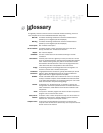
80 Microsoft Broadband Networking Wireless Notebook Kit User’s Guide
network adapter A computer circuit board, card, or other device used to provide
network access from a computer to other parts of the network – for
example, to another computer, a printer, or a base station (gateway
or router). Adapters can be installed inside a computer, inserted into
a computer’s expansion slots, or connected to a computer’s ports.
NIC Acronym for “Network Interface Card.” A circuit board, expansion
card, or other device used to provide network access to a computer
or other network component, such as a printer. Network interface
cards do the actual sending and receiving of data.
packet A unit of information transmitted as a whole from one device to
another on a network. This is often a piece of a file that has been
divided up for efficient transmission over the Internet.
PC Card A credit card-sized device that is inserted into a slot on a computer,
usually a notebook computer.
PCI Acronym for “Peripheral Component Interconnect.” A specific local
bus type that allows up to 10 PCI-compliant expansion cards to be
installed in a computer. This architecture is designed to speed up
system performance by allowing some expansion boards to
communicate directly with the microprocessor.
PCMCIA Acronym for “Personal Computer Memory Card International
Association.” This group defined the standards for the PC Card, a
type of expansion card designed for notebook computers.
peer-to-peer network A network of two or more computers that connect directly with one
another.
Plug and Play Sometimes abbreviated “PnP.” A set of specifications that allow a
computer to automatically detect and configure various peripheral
devices, such as monitors, modems, and printers. See “UPnP.”
port This term has several meanings: (1) A physical connection through
which data is transferred between a computer and another
computer, a network, and other devices (such as a monitor, modem,
or printer). (2) A software channel for network communications.
When a client computer communicates through a network with a
server, it sends its request over a certain numbered channel, called
a “port.”
port forwarding When a base station, gateway, or router passes information between
your network and the Internet, it filters the information based on
which software (virtual) ports are being used and how those ports
are configured. For example, Internet (HTTP) communication, by
default, travels over port 80. To help ensure security, all other ports
are blocked from transferring data unless you specifically configure
those ports to “forward” incoming data to other locations.
PPP Acronym for “Point-to-Point Protocol.” A widely used data link
protocol for transmitting data packets over dial-up telephone
connections, such as between a computer and the Internet.


















